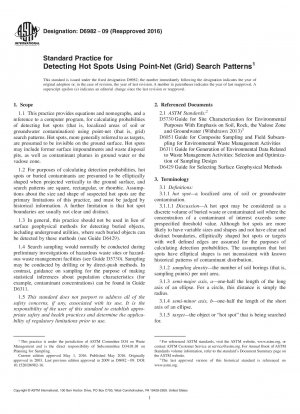ASTM D6982-09(2016)
Standard Practice for Detecting Hot Spots Using Point-Net (Grid) Search Patterns
- Standard No.
- ASTM D6982-09(2016)
- Release Date
- 2009
- Published By
- American Society for Testing and Materials (ASTM)
- Status
- Replace By
- ASTM D6982-22
- Latest
- ASTM D6982-22
- Scope
4.1 Search sampling strategies have found wide utility in geologic exploration where drilling is required to detect subsurface mineral deposit, such as when drilling for oil and gas. Using such strategies to search for buried wastes and subsurface contaminants, including volatile organic compounds, is a logical extension of these strategies.
4.2 Systematic sampling strategies are often the most cost-effective method for searching for hot spots.
4.3 This practice may be used to determine the risk of missing a hot spot of specified size and shape given a specified sampling pattern and sampling density.
4.4 This practice may be used to determine the smallest hot spot that can be detected with a specified probability and given sampling density.
4.5 This practice may be used to select the optimum grid sampling strategy (that is, sampling pattern and density) for a specified risk of not detecting a hot spot.
4.6 By using the algorithms given in this practice, one can balance the cost of sampling versus the risk of missing a hot spot.
4.7 Search sampling patterns may also be used to optimize the locations of additional ground water monitoring wells or vadose zone monitoring devices.
1.1 This practice provides equations and nomographs, and a reference to a computer program, for calculating probabilities of detecting hot spots (that is, localized areas of soil or groundwater contamination) using point-net (that is, grid) search patterns. Hot spots, more generally referred to as targets, are presumed to be invisible on the ground surface. Hot spots may include former surface impoundments and waste disposal pits, as well as contaminant plumes in ground water or the vadose zone.
1.2 For purposes of calculating detection probabilities, hot spots or buried contaminants are presumed to be elliptically shaped when projected vertically to the ground surface, and search patterns are square, rectangular, or rhombic. Assumptions about the size and shape of suspected hot spots are the primary limitations of this practice, and must be judged by historical information. A further limitation is that hot spot boundaries are usually not clear and distinct.
1.3 In general, this practice should not be used in lieu of surface geophysical methods for detecting buried objects, including underground utilities, where such buried objects can be detected by these methods (see Guide D6429).
1.4 Search sampling would normally be conducted during preliminary investigations of hazardous waste sites or hazardous waste management facilities (see Guide D5730). Sampling may be conducted by drilling or by direct-push methods. In contrast, guidance on sampling for the purpose of making statistical inferences about population characteristics (for example, contaminant concentrations) can be found in ......
ASTM D6982-09(2016) Referenced Document
- ASTM D5730 Standard Guide for Site Characterization for Environmental Purposes With Emphasis on Soil, Rock, the Vadose Zone and Ground Water
- ASTM D6051 Standard Guide for Composite Sampling and Field Subsampling for Environmental Waste Management Activities
- ASTM D6311 Standard Guide for Generation of Environmental Data Related to Waste Management Activities: Selection and Optimization of Sampling Design
- ASTM D6429 Standard Guide for Selecting Surface Geophysical Methods
ASTM D6982-09(2016) history
- 2022 ASTM D6982-22 Standard Practice for Detecting Hot Spots Using Point-Net (Grid) Search Patterns
- 2009 ASTM D6982-09(2016) Standard Practice for Detecting Hot Spots Using Point-Net (Grid) Search Patterns
- 2009 ASTM D6982-09 Standard Practice for Detecting Hot Spots Using Point-Net (Grid) Search Patterns
- 2003 ASTM D6982-03 Standard Practice for Detecting Hot Spots and Buried Objects Using Point-Net (Grid) Search Patterns

Copyright ©2024 All Rights Reserved